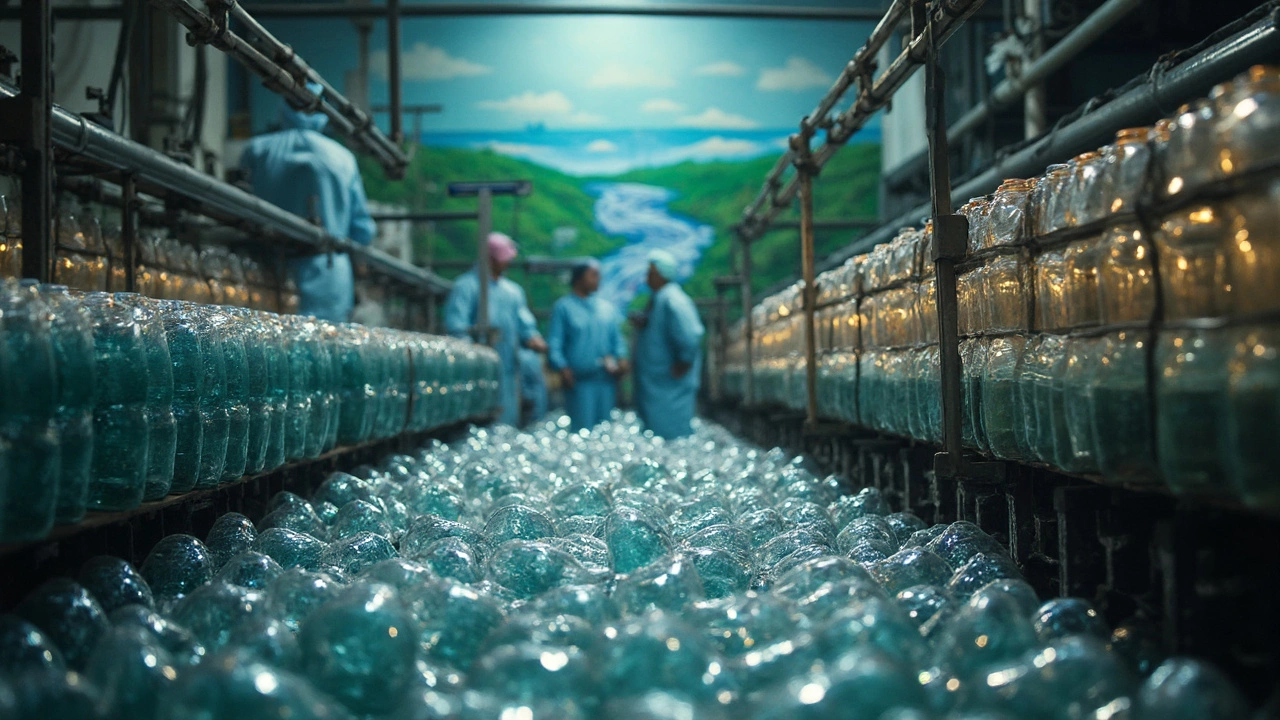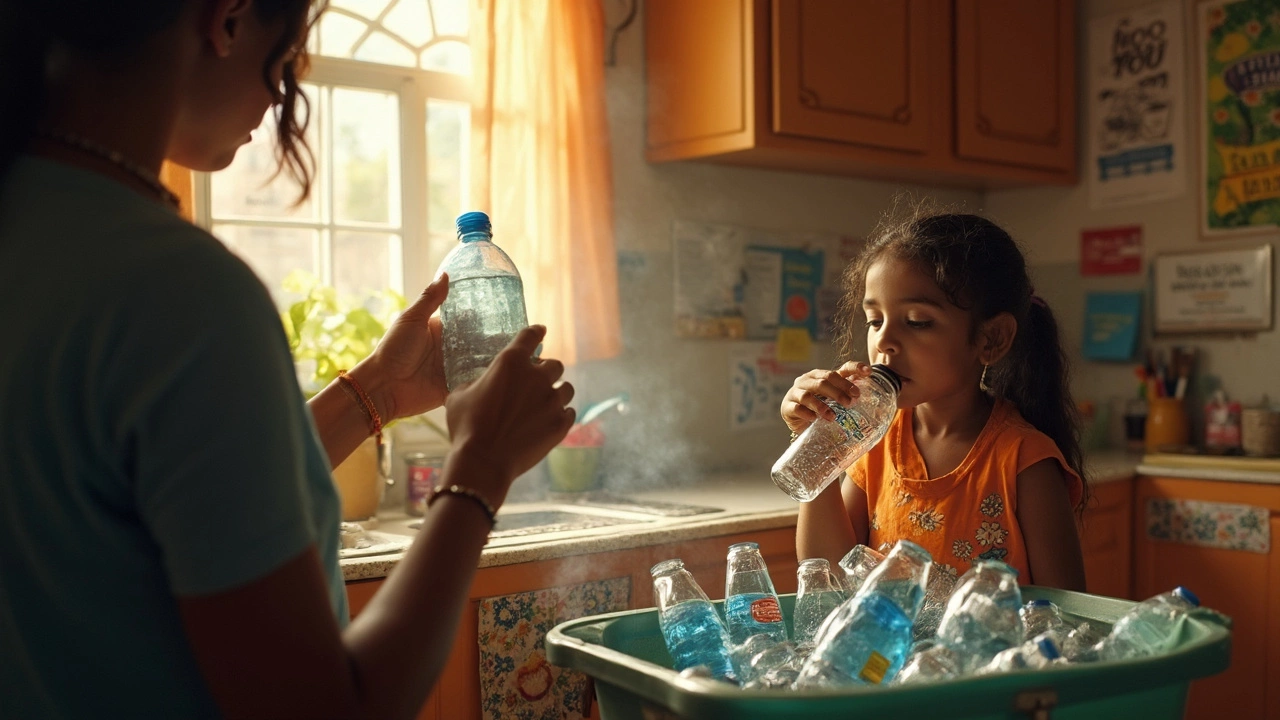Ever wonder which plastic item ends up in the trash more than any other? It’s plastic bottles—by a landslide. Walk around any park, schoolyard, or city block, and you’ll spot at least one squished-up water or soda bottle poking out of the bin (or worse, the ground). The numbers back it up: every minute, people buy over one million plastic bottles globally. Most are used once and then chucked, with only about 30% ever getting recycled.
Why does this matter? Bottles don’t just disappear. They stick around for centuries, breaking into tiny pieces that make their way into rivers, oceans, and even the food we eat. If you’re grabbing a drink for yourself or your kids, that quick choice can add up to a much bigger problem. Instead of getting overwhelmed by the big picture, let’s look at what really happens to these bottles and what can be done—by all of us, and yes, even by the companies making them.
- Plastic Bottles: The Top Polluter
- The Manufacturing Boom and Bust
- What Happens After the Bin?
- Hidden Impacts on the Environment
- Easy Swaps to Cut Down Waste
Plastic Bottles: The Top Polluter
It’s wild how quickly plastic bottles pile up. Every year, the world goes through about 500 billion plastic bottles. That means if you lined them all up, they’d circle the planet more than four times. What’s worse, almost one out of every two plastic bottles isn’t properly collected after use. Instead, they end up buried in landfills, floating in rivers, or gathering up in massive patches in the ocean.
Take a look at this quick breakdown to see just how out of hand bottle waste has gotten in recent years:
| Year | Bottles Sold Globally (in billions) | Recycling Rate |
|---|---|---|
| 2016 | 480 | ~29% |
| 2020 | 500 | ~30% |
| 2024 | 520 | ~31% |
If you’re drinking bottled water in the U.S., chances are it’s packaged in PET plastic, one of the most common materials for single-use bottles. PET is recyclable, but most people toss their bottles in regular trash, missing the chance to give these plastics a new life. No wonder experts call plastic bottles the poster child of waste.
For families like mine (trust me, with kids like Vihaan and Kaia, plastic waste can stack up fast), it means we need to pay attention to how often we buy and toss these bottles. Sometimes, it’s as simple as grabbing a refillable bottle before leaving the house. The less we grab and go, the less we’re adding to the world’s plastic mountain.
The Manufacturing Boom and Bust
Let’s be real—plastic bottles didn’t just show up out of nowhere. The plastics industry started pumping them out big time in the 1970s. Since then, demand has exploded. Big reasons? Convenience, low cost, and how easy it is to grab a bottle and go. Today, a handful of massive companies drive most of the production, and their factories crank out billions every year.
According to the International Bottled Water Association, the U.S. alone sold over 15 billion gallons of bottled water in 2023. Globally, the numbers are jaw-dropping: about half a trillion plastic bottles are produced each year. Most are made from PET (polyethylene terephthalate), which is cheap to produce but sticks around for centuries if not recycled.
| Year | Bottles Produced (Worldwide) |
|---|---|
| 2004 | ~200 billion |
| 2016 | ~480 billion |
| 2023 | ~500+ billion |
Why so much growth? Simple: marketing made single-use bottles cool and necessary, especially for water. But here’s the catch—the recycling side can’t keep up with all this production. According to the Ellen MacArthur Foundation, “By 2050, there could be more plastic than fish in the ocean, pound for pound, unless we change things fast.”
“If trends continue, by 2050 plastic production could account for 20% of global oil consumption.” — Ellen MacArthur Foundation
On the flip side, lots of plastic bottles never make it to recycling facilities. Limits in local recycling programs, confusion over what’s recyclable, and the sheer number of bottles being tossed every minute just make the problem worse. The bust part? All these discarded bottles end up overwhelming landfills, polluting rivers and beaches, and costing cities big bucks to clean up.

What Happens After the Bin?
A lot of folks think tossing a plastic bottle in the recycling bin solves the problem, but that’s not quite how things play out. Most plastic bottles are made of PET (polyethylene terephthalate), which is technically pretty easy to recycle. The trouble is, the journey is full of roadblocks. Only about 30 out of every 100 bottles in many countries actually make it through the recycling process. The rest? They go to landfills, are burned, or, even worse, end up floating in rivers and oceans.
Here’s what usually happens when you toss a bottle:
- Collection & Sorting: Bottles are picked up from recycling bins and sorted at facilities. But if a bottle is dirty or has the wrong cap, it might get thrown out right there.
- Cleaning & Shredding: If the bottle passes the first hurdle, it’s washed and shredded into flakes. These are sold to companies who use them for new products, like another bottle or even fabric for t-shirts.
- Actual Recycling: Only high-quality, clean bottles get recycled. Anything contaminated by food or liquids usually ends up in the trash after all.
- Landfill or Incineration: Bottles that don’t get recycled are either buried (where they stick around for centuries) or burned, which creates pollution.
A 2022 report broke down where bottles go after we toss them:
| Process | Percentage of Bottles |
|---|---|
| Recycled | 30% |
| Landfill | 50% |
| Incinerated | 15% |
| Leak into Environment | 5% |
Some countries do way better with bottle recycling. For example, Germany and Norway have deposit systems that return cash for every bottle. These programs keep over 90% of bottles out of the landfill. Compare that with the US, where only about one in four plastic bottles ever meet the recycler.
So, what’s the bottom line? Dropping a plastic bottle in the "right" bin is just one part of the whole story. Without good systems, strict sorting, and people actually caring, even well-intentioned recycling often misses the mark. It’s easy to see why plastic bottles keep piling up unless everyone—companies included—steps up their game.
Hidden Impacts on the Environment
You know what's wild? A single plastic bottle can hang around in the environment for up to 450 years. That's not just a random number—it means every bottle we toss today could still be here when our great-great-grandkids are. Most people think tossing bottles in the trash is no big deal, but there's a ripple effect.
First up, making plastic bottles guzzles oil and water. It takes about 3 liters of water to make just 1 liter of bottled water, so you’re actually wasting more than you’re drinking. Plus, the plastic is made using fossil fuels. That means more drilling, more pollution, and a bigger carbon footprint from something most of us use for a couple of minutes.
Then there's the mess after these bottles leave our hands. Many end up in landfills or the ocean. In the ocean, sunlight and waves break bottles into smaller pieces called microplastics—plastic bits so tiny they can get eaten by fish and end up in the food chain. Studies have found microplastics not just in sea life, but in tap water and even salt. So when you look at your table, chances are there’s a bit of plastic sneaking onto your plate.
Here’s a quick look at where discarded plastic bottles usually land:
| Destination | Percentage |
|---|---|
| Landfills | ~57% |
| Recycled | ~30% |
| Incinerated | ~13% |
The biggest worry? Wildlife. Animals often mistake bottles or their caps for food, leading to issues like blocked stomachs or even starvation. You might’ve seen heartbreaking photos of birds or fish tangled in bottle rings or filled with plastic bits. It’s not rare—it’s happening all the time.
When you hear about pollution, most people zero in on bags or straws, but plastic bottles are quietly doing just as much damage, if not more. Knowing this, it makes sense to look for ways to use fewer bottles and push companies to come up with better alternatives. Every small change piles up.

Easy Swaps to Cut Down Waste
Cutting down on plastic bottle waste isn’t rocket science. It actually starts with a handful of simple swaps that anyone can make, no matter your schedule or budget. The biggest game-changer? Ditching single-use bottles. In the US alone, about 35 billion empty bottles get tossed every year. Just swapping to a reusable water bottle can keep hundreds of those out of the landfill every year, per person.
- Buy a reusable bottle: Stainless steel or BPA-free plastic, there’s really something for everyone. Keep it filled and skip the store-bought drinks.
- Refill stations: More cafes, schools, and public spaces have free water refill points now. My kids, Vihaan and Kaia, even refill theirs at school instead of buying new plastic bottles every day.
- Soda at home: Devices like SodaStream can make sparkling water in reusable bottles, cutting down single-use bottles big time.
- Choose glass or carton packaging: When grab-and-go’s a must, look for drinks in glass or cardboard. They’re both easier to recycle.
- Support brands with recycling programs: Some drink companies let you return bottles right to the store for a discount or reward.
A study from National Geographic found, "If just 1 in 10 people stopped buying single-use plastic bottles, we could keep billions of bottles out of the waste stream every year."
| Product | Average Uses Per Year | Plastic Bottles Avoided |
|---|---|---|
| Reusable Bottle | 365 | 167–200 |
| Soda Maker | 150 | 120–170 |
Even one swap from the list above can make a big dent, fast. And the best part? These aren’t expensive moves, but they definitely add up. The small changes at home and at work actually help slow the flood of tossed bottles, keeping them out of the soil, water, and food. If you want to go further, try talking to your workplace or your kids’ school about adding more refill stations or bottle return options.
